Once a thriving neighborhood home to middle managers of the Steel Mills that resided down below on the Monongahela river valley, the South Hilltop neighborhood of Knoxville is a topographically diverse area with a collection of flat streets and hilly avenues with modest slopes. The neighborhood is densely populated by brick single family homes and subdivided rentals. And no, I’m not talking about Knoxville, Tennessee; something I have to correct all too often when I speak of Knoxville to other longtime Pittsburghers (who did not grow up south of the Monongahela river). Anecdotally speaking, Knoxville is one of the many struggling Pittsburgh neighborhoods that seem to escape the attention and awareness of those Pittsburghers who don’t know the south end of the city beyond the South Side Flats. The neighborhood is bordered to the north by Cedarhurst Street, to the west by Beltzhoover Avenue and Tarragonna Street, to the east by Amanda Avenue and Brownsville Road and to the south by St. John Vianney Cemetery (the place where my grandma and cousins rest). The neighborhoods of Allentown, Beltzhoover, Bon Air, Carrick and Mt. Oliver Borough (the only suburb completely surrounded by city neighborhoods) are north, northwest, southwest, south and east of Knoxville, respectively. When atop some of Knoxville’s steeper slopes, the northern part of the neighborhood is in full view with the U.S Steel building towering over the horizon. Truly, Knoxville is a complicated place, but one that has always felt like home to me (and a neighborhood that I adore).

Knoxville is located in Pittsburgh’s South Hilltop region.
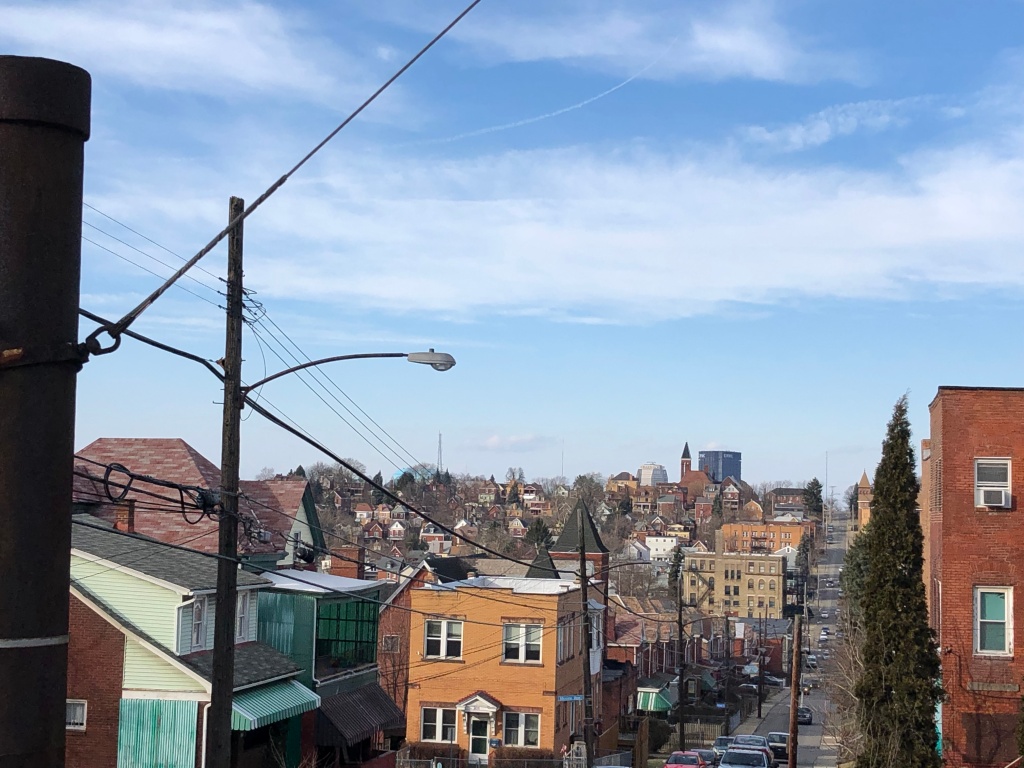
The neighborhood of Knoxville was named after the fruit farmer Jeremiah Knox who settled there in the early 1800s and was known for his strawberries. The neighborhood was once home to Shade trees that lined the streets. Several streets were named after Knox’s extended family and others were named after the literal fruits of his labor: such as Rochelle Street, Amanda Avenue and Charles Street, and Jucunda Street and Orchard Place, respectively. The neighborhood was a desirable site for farming because of two topographical shelfs that blocked out the smoke and smut from the Steel Mill below in what is now known as the South Side Flats, and shut out smoke from other mills lining the Monongahela river. The first shelf is a feature of Allentown and the South Side Slopes and the second is a topographical slope down from Cedarhurst Street. As the neighborhood became more accessible via the Mt. Oliver incline in the 1870s and via the Knoxville and St. Clair Electric railroad in 1888, the population began to increase and drove dense residential development. Managers of the South Side steel mills preferred Knoxville because of its low level of pollution and easy access to the South Side Flats. The neighborhood was annexed by the City of Pittsburgh in 1927.
Knoxville is 1 of only 7 neighborhoods and neighborhood areas in the City of Pittsburgh with no clear simple racial majority. The neighborhood is roughly 46% black, 40% white, 6% Asian, 6% biracial and 2% Hispanic or Latino – per 2017 5-year American Community Survey estimates. And it’s important to state that this racial mixing wasn’t by design. Like many other neighborhoods and suburban boroughs along the Monongahela river valley, Knoxville began to steeply decline in population as the Steel Mills shuttered and closed in the late 70s and early 80s. Even before the decline of the mills, neighborhoods like Knoxville were subject to the same sort of depopulation trends happening throughout the city as a whole from the 1950s onward – due to increasing suburbanization and White flight. And as the population continued to decline decade after decade, neighborhood churches, schools, local institutions and businesses on the Knoxville side of Brownsville Road closed as well. While there are no longer any secondary schools that are currently open in the neighborhood, the teenagers of Knoxville feed into Carrick High School – much like my mom did when she was young.

The neighborhood is a microcosm of the consequences of de-industrialization and depopulation across the U.S. As those who were able/willing to leave the neighborhood did, the poverty rate began to steadily rise. Only those families who were left behind remained, along with those families who intended to whether the change. Racial mixing did not so much occur via some package of intentional integration policies, but instead as the result of the demolition of Public Housing projects throughout the City of Pittsburgh (such as the former St. Clair Village in the 2000s) and by way of Knoxville remaining transit accessible and having cheaper rents (comparatively) than economically similar neighborhoods in more opportunity rich parts of Pittsburgh.
Despite my existing knowledge of the neighborhood from my spending time there as a child and teenager, my street by street walk of the neighborhood revealed just how racially divided the neighborhood is; something I had never quite realized when I was younger. South Knoxville appeared to be home to many White residents. I even spotted some “Don’t Tread on Me” flags dotted throughout the southern tip of the neighborhood; a reminder of the more conservative political tendencies of working-class White residents throughout the Hilltop and south Pittsburgh – despite their economic status and position. This feature was true of my own home growing up in Brookline, although as one that was quite poor. And obviously, not all working class White residents fall into this political category. As I walked north of Suncrest Street, the residents walking the neighborhood were increasingly Black. And despite notable exceptions of integrated groups of White and Black residents in the neighborhood, some of the Black residents I spoke to on my walk reinforced the notion of how different it is to be Black in Knoxville. Their resident interview can be read here.
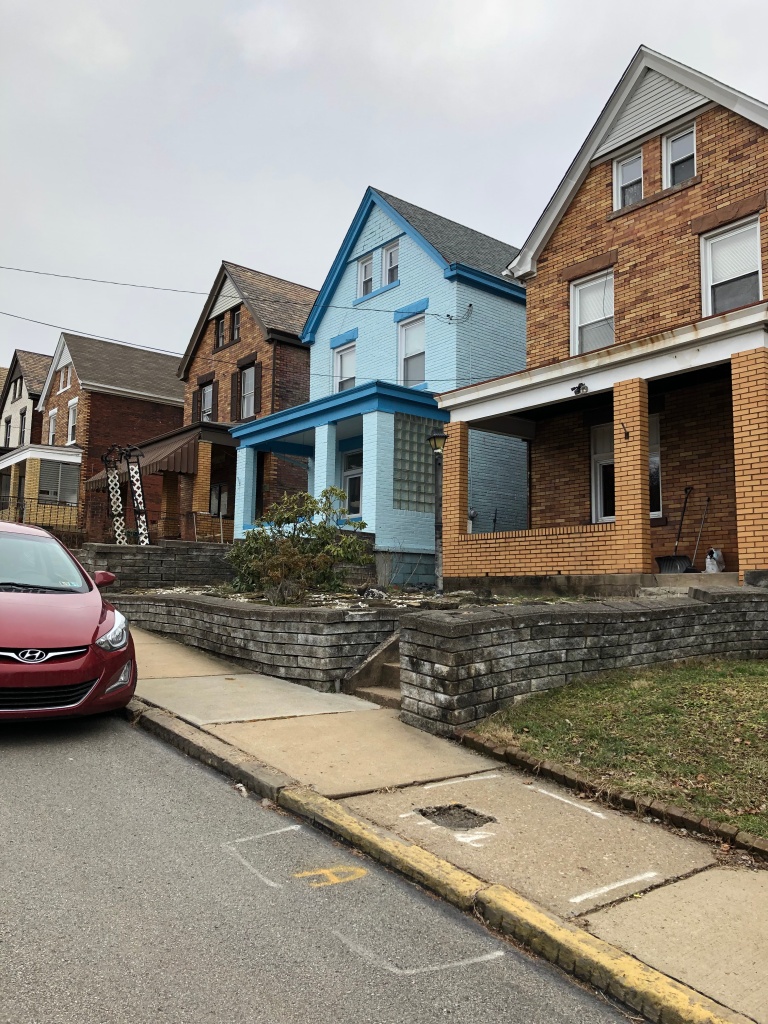
Remnants of the once tree-lined streets are still present in south Knoxville and the housing stock is sturdy and compact. Much like my walk throughout Manchester, while dilapidated housing was littered throughout the entire neighborhood, its concentration tended to increase as I walked northward – especially so north of Bausman Street. A number of vacant lots broke open the otherwise dense housing landscape. But beautiful housing is present throughout the whole of the neighborhood and I have my own affinity towards my mom and Grandma’s old home on Rochelle street in the northern part of Knoxville. Wide open vistas of the neighborhood can be viewed at the top of the certain alley ways and steeples of closed churches still permeate the neighborhood; including the now closed St. Canice on Orchard Place – which was the place where my sisters and I were baptized into the Catholic Church. While a small number of bars and convenience stores reside on the Knoxville side of Brownsville Road, a number of former businesses are vacant. Aprimo Pizza, Napa Auto Parts, McDonald’s and the remodeled Carnegie Library of Pittsburgh also call the Brownsville Road business corridor home. While not in Knoxville, the bars, stores and convenience shops of Mount Oliver Borough are nearby.

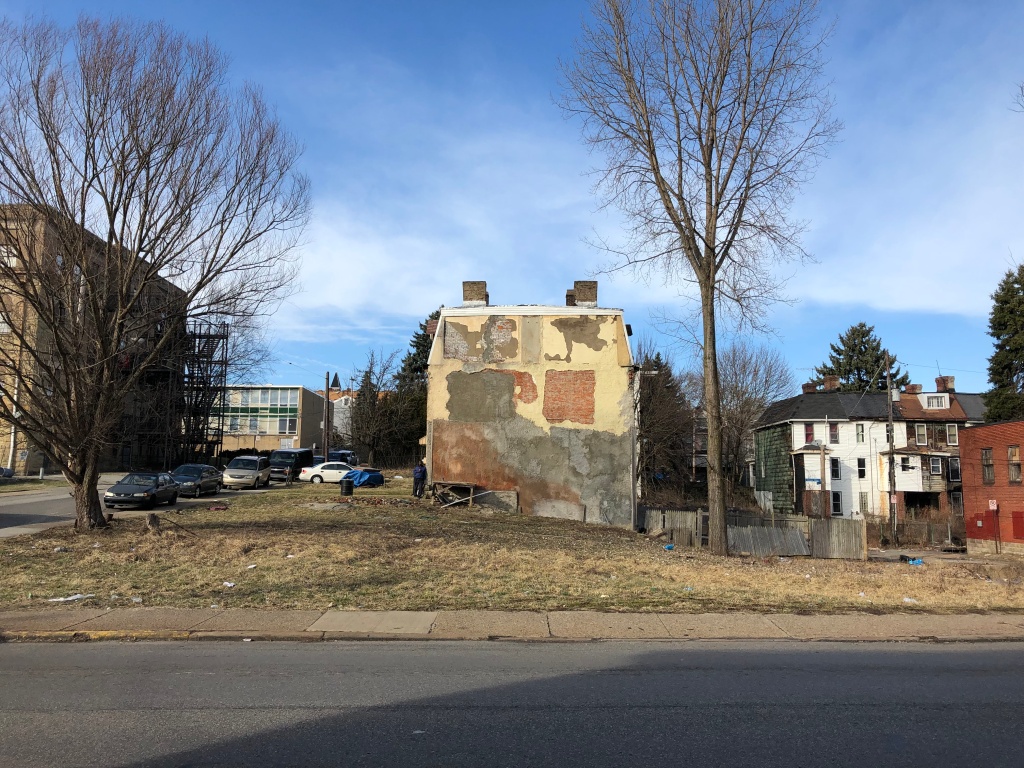
Unlike the small portion of formerly disadvantaged and poverty-stricken Pittsburgh neighborhoods that are rapidly emerging in rent and home value and declining in poverty and other measures of disadvantage, Knoxville is like most other high and extreme poverty neighborhoods in that it has gained in poverty overall and has remained durably poor for decades. While Knoxville’s estimated poverty rate has fluctuated over the years, the rate of individuals living below the federal poverty line increased by 11 percentage points from 1990 to 2017 (19% to 30%) and the poverty rate has generally stayed upwards of 30% in recent years. High poverty Knoxville has also continued to see its population decline with a loss of 968 residents from 2012 to 2017 – with an estimated population of 4,333 in 2012 and of 3,365 in 2017. Like is found in most Pittsburgh neighborhoods that will also be profiled, steep racial divides exist between the Black and White population regarding median income and poverty rate – even in such a high poverty setting. While both the White poverty rate and Black poverty rate saw declines from 2012 to 2017 (a decline of 7.9% and 5.6%, respectively), the Black poverty rate is still 5.4 times that of the White Poverty Rate (43% for Black people and 7.9% for White as of 2017). And while the White household median income has increased from an estimated $43,757 to $45,794.00 over the 5-year period, the Black household median income has declined by a percentage change of 34% (from $27,972 to $18,537 or a difference of nearly $9,500). The White population also grew by 4% and the Black population declined by 9% over this time – with a 4% increase in the multiracial population.
Knoxville estimated measures of need and value are mixed regarding gains and declines from 2012 to 2017. Regarding measures of value, median gross rent and median home value have declined in the past 5-years (from $861 to $792 and from $46,635 to $44,300, respectively). Indicators of need such as those living below the FPL have decreased by 7% (down from 37%), single mothers with children has decreased by 14% (down from 37%), and those 25 and above with at least a bachelor’s degree or more have decreased by 4% (from 91% to 87%). However, while these declines in need may symbolize more significant change, they must be put in context. As of 2017 ACS estimates, and among all other Pittsburgh neighborhoods and neighborhood areas, Knoxville had the 8th highest rate of single mothers with children, the 7th highest rate of males who are unemployed or unattached from the labor force (when removing college student heavy neighborhoods from the rankings), the 12th highest rate of those 25 and up without a Bachelor’s degree or more, the 11th lowest median Black household income (when removing college student heavy neighborhoods from the rankings) and the 5th lowest median home value in all of Pittsburgh. And so, despite these declines in need, need levels are still quite high in both real terms and comparatively. These high measures of need come with a heavy cost on the community for such factors have contributed to the relatively high rate of gun violence found in durably poor neighborhoods like Knoxville.
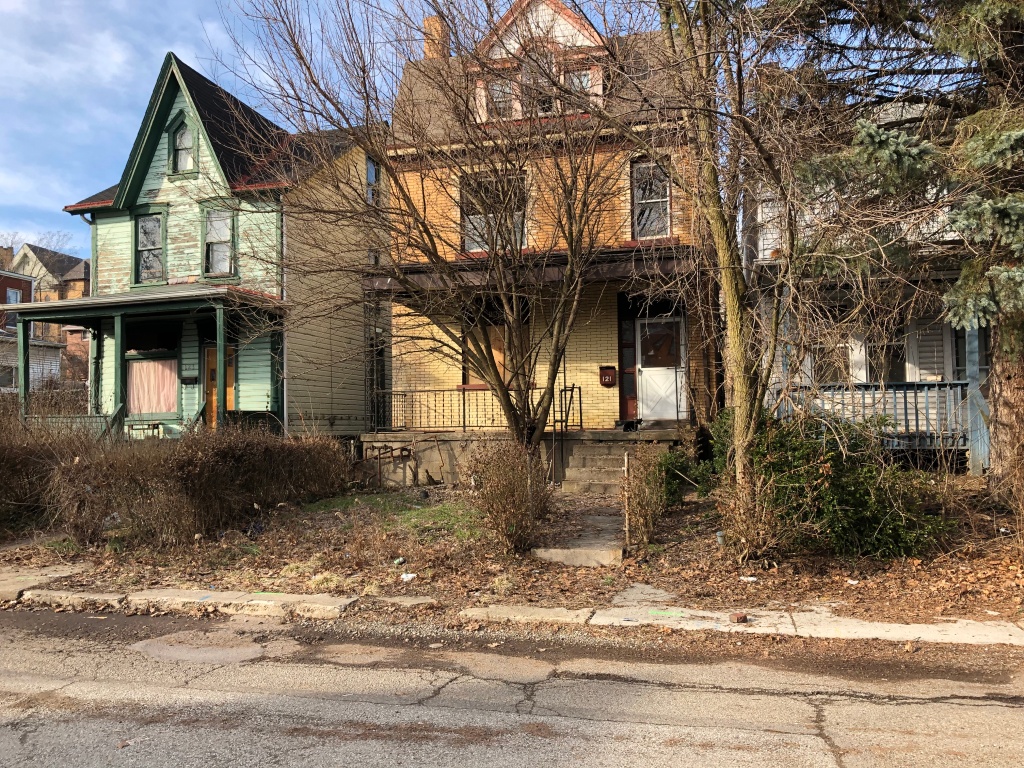
In 2018 alone, 3 young men lost their lives to gun violence in Knoxville: James Loughlin (a 23-year-old white male), Tamon Hatchin (a 24-year-old Black Male) and Anthony Bullock-Fields (a 29-year-old Black male). And on Friday, February 8th 2019, a home invasion resulted in the hospitalization of a suspect and home resident due to gun fire exchange. And sadly, gun violence has been present in Knoxville for years. In 2014, 36-year-olds Jason Eubanks and Cheralynn Sabatasso were shot and killed. In 2015, 15-year-old Curtis pounds was a 9th grader at Carrick High School who was shot and killed. Curtis’s Aunt said that Pound’s father had been shot and killed 6 years ago and that her sister had also been murdered in 1993. In 2015, Police Officers shot and killed a fugitive charged with rape of a young child, assault and other crimes. According to police, the man had held what turned out to be an all-black air gun “in a manner consistent with what one would see when trained to use a handgun against officers.” In 2016, a 6-year-old Black girl named Isis Allen was tragically shot in the head by stray bullets in the summer of that year. 23-year-old Black female Shanique Sanders was shot down and found dead on McKinley Street in November of 2016. In March of 2017, a murder/suicide occurred when 46-year-old Christopher Dancy was shot and killed by 47-year-old Joseph Goldsmith before turning the gun on himself. A 9-month year old infant was injured from glass due to an exchange of fire between two men in April of 2017. In November 2017, 52-year-old Black woman Regina Beck Jordan was found shot in the head in her dining room on Rochelle Street and hospitalized. In July 2018, a man was shot at the intersection of Bausman and Brownsville Road and was taken to the hospital in stable condition. And in November of 2018, an 18-year-old man was taken to the hospital in critical condition after multiple wounds to the abdomen. This is not an exhaustive list, but a large snippet of gun violence that has occurred in Knoxville over the past few years. In being brutally honest, I cried when I read this list aloud to my younger brother – because so many of these young men and women were taken due to circumstance.
To be quite explicit, social science research shows that community level measures of concentrated poverty, percentage of men unemployed or unattached to the labor force, percentage of single mothers with children, drug trafficking and its connection to gun violence and other structural variables of disadvantage all have a hand in creating the conditions and opportunities for gun violence to disproportionately occur in high poverty areas like Knoxville. Meaning, gun violence is often a matter of economic circumstance and disadvantage, and is not some moral or cultural failing of the people who reside in durably poor communities. And often, it is carried out by a small percentage of the younger population who cause a disproportionate amount of the violent crime. And regarding the high degree of gun violence in majority Black neighborhoods (along with the fact that 69% of all victims of homicide in 2018 were Black – despite the fact that Black people make up only 13% of Allegheny County’s population), urban researchers argue that the high degree of gun violence in impoverished Black and mixed race communities is a matter of proximity and multigenerational exposure to highly disadvantaged neighborhoods. Meaning, because majority Black neighborhoods in Pittsburgh (and else where) tend to be so durably high poverty and segregated, young Black people are much more exposed and at risk to gun violence as compared to White people because of the neighborhoods and economic circumstances that they were born into. The exception of Knoxville is that it is a racially mixed neighborhood – albeit one that is still segregated. As such, both White and Black residents are exposed to both the economic and systemic conditions that cause the gun violence and the gun violence itself. Meaning, high gun violence is not an issue of race, but of the factors that create it – as described. However, the factors that create it have often been historically and systemically tied to areas of Black concentrated poverty.
The neighborhood conditions that tend to predict violence are the result of systemic and macroeconomic forces and self-reinforcing patterns of multigenerational exposure to concentrated poverty and disadvantage. Researchers Robert Sampson and Patrick Sharkey have analyzed and written on these topics extensively (see Chicago and the Enduring Neighborhood Effect and Stuck in Place). As discussed in a previous data brief, Black people are far more likely to reside in areas of concentrated poverty in Pittsburgh than White people are. As found in the analysis, an overwhelming 76% of majority Black neighborhoods are considered high or extreme poverty as of 2017 ACS estimates – compared to a mere 6% of majority White neighborhoods that are considered high or extreme poverty (with poverty rates exceeding 30% to 40% or more).

In one of the most cited papers of the past few decades regarding the structural causes of violent crime in racially and economically segregated neighborhoods, renowned researchers William Julius Wilson and Robert Sampson of Harvard argued that the rate of unemployed or unattached males to the labor force and concentrated poverty tend to disrupt families and affect the rate of single mother households with children. In turn, it has been found that high rates of single mothers with children is a leading predictor of violent crime – especially so among juveniles. More recent research from Sampson shows how higher rates of incarceration among Black men have also disrupted the family and led to an increase in single female houses with children. Regarding higher rates of incarceration, Sampson found that the rates of incarceration among Black men in Chicago neighborhoods for committing the same crimes as White men is a different of kind, not degree. While both researchers don’t ignore the fact that neighborhood culture may play some role in violence, they argue that cultural primers of violence are a response to the overwhelming disadvantage of many racially and economically segregated neighborhoods and the lack of living wage job opportunities for residents. Now, violent crime is complex, but my point is that structural variables at the neighborhood level tend to be quite predictive of crime. And as discussed, Knoxville has some of the highest rates of single mothers with children and men who are unemployed or unattached to the labor force in the City of Pittsburgh.

Knoxville, like many other durably poor neighborhoods in Pittsburgh, is a complicated place. While it is measurably disadvantaged as compared to low poverty neighborhoods in Pittsburgh, it is also home to residents who deeply care about their neighborhood and are doing their best to get by. And many are resilient, friendly, knowledgeable and charismatic – per my own personal experiences with family and friends in Knoxville and per my street by street walk of the neighborhood. Although not by design, Knoxville is one of the most racially diverse neighborhoods in the entire city, but it is still segregated when comparing the southern and northern sections of the neighborhood. Knoxville has access to transit via the 51, 44 and 54, but there is only one grocery store in the entire South Hilltop. Knoxville has sturdy, compact and wonderfully charming homes, but a high degree of vacancy and blight. Knoxville is the place where my mom and most of my mom’s side of the family grew up. And my grandma’s house holds a special place in my memory; whether the memory be of her neighborhood famous rigatonis or the times when my great-uncle would chase me around her house with a buzz cutter because my hair was “way too damn long.” I once received some sage advice from my Great Uncle Bill. Uncle Bill also resided with my grandma in the house with the Japanese Apple Tree out front and the dark green porch swing that my siblings and I would play on when we were younger. He told me that a boy who never ended up in the hospital from doing something reckless with his friends would never really have that great of a childhood (and my best friend and I took his advice a bit too seriously growing up).
Knoxville is home to beautiful vistas and a visibly tight social network but is plagued by community violence that is preventable. Knoxville is struggling, as are many of its most vulnerable residents, but its story doesn’t have to end that way – nor should it. While Knoxville is one of many high poverty neighborhoods that has not seen the benefit of Pittsburgh’s so-called renaissance and revitalization, there are strategies out there that aim to invest in the people of disadvantaged places and provide them with real opportunity. And there are already local non profits that deeply care about the social mobility and health of those residing in the Hilltop (such as the Brashear Association and the Hilltop Community Children’s Center). Pittsburgh’s economic growth alone will not solve the problems of durable poverty and cemented disadvantage in places like Knoxville. Intentional place-based and people centered policies, investments and strategies are needed to combat the barriers that residents have faced for generations.
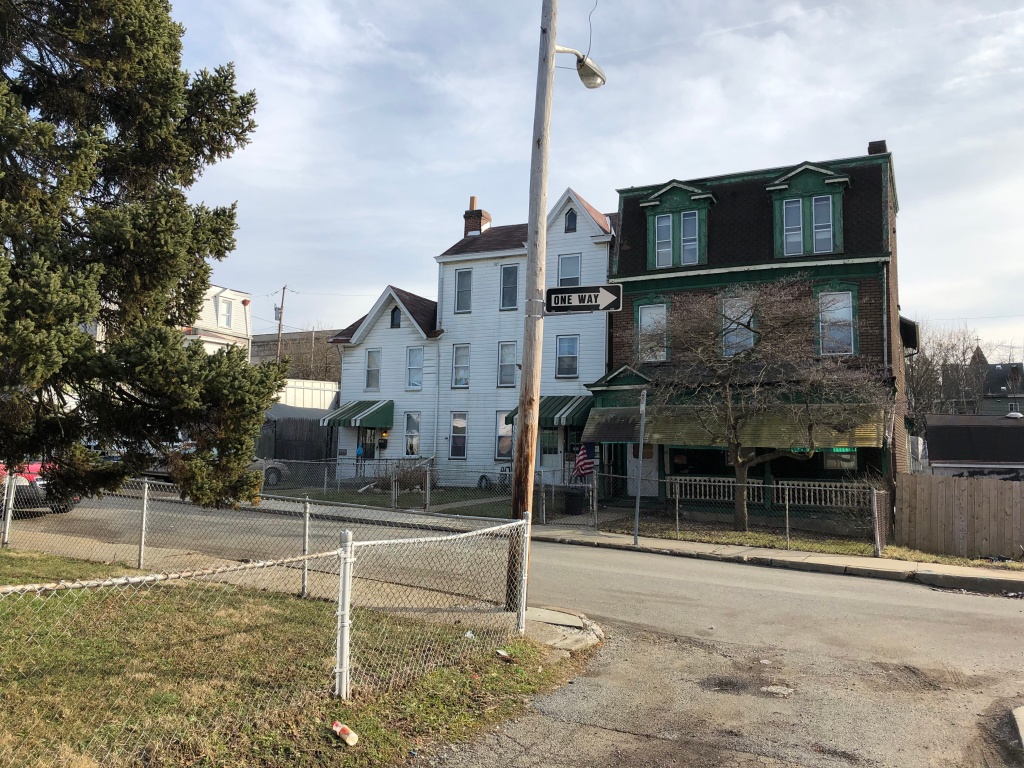
Methodology Notes
All neighborhood level statistics were gathered via census tract level data from the 2012 to 2017 5-year American Community Survey estimates. Citywide statistics were gathered via the 2017 1-year ACS estimates. The 1990 poverty rate was gathered via poverty estimates from the National Historic Geographic Information Systems. The University of Pittsburgh Library System informed which census tracts comprised a given neighborhood in a given year. 2012 dollar amounts, incomes and values were adjusted for inflation using the consumer price index.
ACS estimates at the census tract level have sizeable margin or error and this may impact results.
Snippets of broader Pittsburgh history were not cited because they are common knowledge.
In neighborhood profiles and data briefs, neighborhoods and neighborhood areas are considered to have a simple racial majority when a given race constitutes 51% of the total population. Otherwise, it is considered a mixed-race neighborhood.
Poverty intervals were informed by standards in neighborhood-level poverty research. Specifically, researcher Patrick Sharkey’s poverty intervals were referenced from his book Stuck in Place – regarding what constitutes an extreme, high, moderate, low or very low poverty neighborhood.

Leave a comment